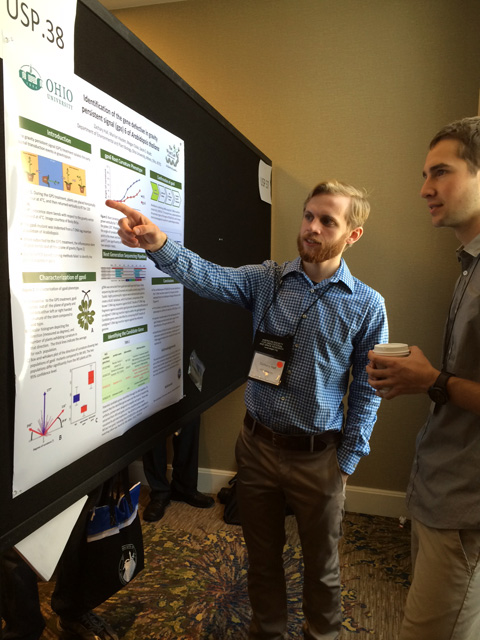Undergraduate student Zachary Hall presented a poster on identifying a genetic mutation in the small, mustard-like plant that allows Ohio University researchers to study the gravitational effect on the plant.
The research on Identification of the Gene Defective in gravity persistence signal (gps) 6 of Arabidopsis thaliana was co-authored by graduate student Marilyn Hayden, undergraduate student Megan Osika, and Dr. Sarah Wyatt, Professor of Plant Biology at Ohio University, all members of Wyatt’s Team Gravitron. Read more about their experiment that will fly on the International Space Station.
Abstract: The gps6 mutant was identified as a gravitropic mutant of Arabidopsis thaliana through the Gravity Persistent Signal (GPS) treatment. When subjected to GPS treatment, the inflorescence stem of gps6 bends out of the plane of gravity. gps6 was isolated from a T-DNA tagged population, and although regions of the tag have been identified in gps6, the PCR based cloning strategies failed to identify the gene disrupted, so a deep sequencing strategy was adopted. gDNA was extracted from gps6 and sequenced.
The resulting sequence data was assembled and aligned to the reference genome. Unaligned sequence reads were assembled and compared against known regions of the T-DNA tag. Four possible candidate genes were identified.
PCR primers were designed to amplify these genes in gps6, but only one gene AT3G03220 showed a disruption in sequence. Mutants for that gene were obtained from the Arabidopsis Biological Resource Center, bred to homozygosity and screened for the gps6 phenotype in the roots and inflorescence stems.
A genetic rescue of the gps6 mutant will confirm the gene’s identity as GPS6 and assist in better understanding the signal transduction pathway of gravitropism.
This work was partially funded by NSF IOS #1147087 to SEW and an Ohio University Undergraduate Research & Creative Activity Award to Hayden.




















Comments